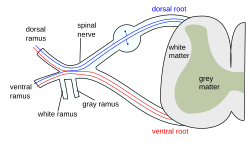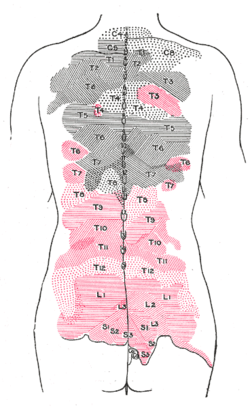Dorsal ramus of spinal nerve
| Dorsal ramus of spinal nerve | |
|---|---|
 Diagram of spinal nerve | |
 Areas of distribution of the cutaneous branches of the posterior divisions of the spinal nerves. The areas of the medial branches are in black, those of the lateral in red. | |
| Details | |
| Identifiers | |
| Latin | ramus posterior nervi spinalis |
| TA98 | A14.2.00.035 |
| TA2 | 6151 |
| FMA | 5983 |
| Anatomical terms of neuroanatomy | |
The dorsal ramus of spinal nerve, posterior ramus of spinal nerve, or posterior primary division is the posterior division of a spinal nerve. The dorsal rami provide motor innervation to the deep (a.k.a. intrinsic or true) muscles of the back, and sensory innervation to the skin of the posterior portion of the head, neck and back.[1]
A spinal nerve splits within the
Structure
Ventral root axons join with dorsal root ganglia to form mixed spinal nerves (below). These then merge to form peripheral nerves. Shortly after this
After it is formed, the dorsal ramus of each spinal nerve travels backward, except for the first
Function
Because each spinal nerve carries both sensory and motor information, spinal nerves are referred to as mixed nerves. Posterior rami carry visceral motor, somatic motor, and sensory information to and from the skin and deep muscles of the back. The posterior rami remain distinct from each other, and each innervates a narrow strip of skin and muscle along the back, more or less at the level from which the ramus leaves the spinal nerve.
References
- ^ a b "ramus posterior nervi spinalis". TheFreeDictionary.com. Retrieved 2023-06-13.
Additional images
-
The formation of the spinal nerve from the dorsal and ventral roots.
External links
- terminologyanatplanes at The Anatomy Lesson by Wesley Norman (Georgetown University) (typicalspinalnerve)

